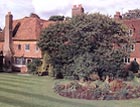The Perfect Setting for a Summer’s Dream
An exclusive preview of Wilsley, a glorious house surrounded by acclaimed gardens, including an open air theatre


Four generations of the Alexander family have lived at Wilsley, on the northern edge of Cranbrook, Kent, since Col Boyd F. Alexander bought the property, and the adjoining Great Swifts estate, in 1862. In 1911, Col Alexander gave Wilsley as a wedding present to his son, Herbert, an amateur actor and gifted watercolourist, and his wife Edith, a talented painter who was taught by Sir William Orpen. Both were enthusiastic members of Cranbrook?s thriving colony of Victorian artists.
Christopher Hussey wrote three articles about Wilsley in Country Life (August 21, 1920, and July 2 and 9, 1948); the first captures the spirit of the place with an evocative picture of Herbert and Edith?s seven year old daughter Camilla, sitting barefoot in the garden, gazing up at a statue of Narcissus. Now aged 93, Mrs Alexander moved to a nursing home in recent years, leaving Wilsley in the hands of her daughter, Ianthe. After much deliberation, she, too, has decided to move on, and this remarkable house is on the market through Knight Frank (01892 515035), at a guide price of £2.25 million.
Miss Alexander recalls driving down from Highgate in her father?s Daimler to visit her grandmother Edith at Wilsley some time in the late 1940s: ?I must have been about three, and I remember feeling very small in such a large house. My grandparents were quite Bohemian, and I remember seeing Ellen Terry, who lived nearby at Tenterden, coming to Wilsley as an old lady, dressed all in black?. Herbert Alexander died in 1948 and, shortly afterwards, Miss Alexander?s parents came to live at Wilsley, at which point her father, a doctor/psychiatrist, took on the Alexander family name and the upkeep of the 11,000sq ft house (now listed Grade I), and its 12? acres of glorious gardens and grounds.
According to Christopher Hussey, Wilsley was originally a 15th-century hall house, owned by a succession of Cranbrook clothiers between the late 1400s and the late 1600s. The house consists of two parallel timber framed ranges, separated by a small inner court. The division of the hall and the insertion of the chimneys is thought to have taken place in about 1530, with the oriel window and the panelling of the main rooms added about 1600. In the late 1600s, John Weston, the last of the Cranbrook clothiers to live at Wilsley, added the casement windows in the gable wings and remodelled the ground and first floors of the north wing. A series of delightful painted panels in the former chapel, now known as the Painted Room, dates from this period.
Members of the Weston family lived at Wilsley until about 1860, but apparently in reduced circumstances, and it was left to Col Boyd Alexander to renovate and extend the house, with the addition of a wing to the north east. The house has many wonderful rooms, among them the Painted Room; the Great Hall, with its magnificent panelling, timbered ceiling and early William & Mary staircase; the parlour with its fine linenfold panelling; the morning room; and the twin aspect dining room, with one window overlooking the courtyard, and the other, the garden. Upstairs, the splendid King Post Room has cathedral like proportions. Wilsley has changed little in the past 60 years or more. Six first floor bedrooms and three second floor bedrooms are served by only two bathrooms a situation a new owner would no doubt modify, as well as upgrading the endearingly old-fashioned kitchen.
Herbert and Edith Alexander created Wilsley?s marvellous gardens, laid out as a series of rooms, often described as being better than those at Sissinghurst. Wide expanses of lawn, framed by clipped yew hedges, are interspersed with banks of rhododendrons and azaleas, more of which enclose the secret garden with its old plunge pool one of the first of its kind. In the past, the open air theatre with its wings of clipped laurel has been the perfect setting for productions of A Midsummer Night?s Dream. For the Alexander family, the dream may be drawing to a close; for their fortunate successors, it is just beginning.
This article first appeared in Country Life magazine on April 13, 2006.
Exquisite houses, the beauty of Nature, and how to get the most from your life, straight to your inbox.
Country Life is unlike any other magazine: the only glossy weekly on the newsstand and the only magazine that has been guest-edited by His Majesty The King not once, but twice. It is a celebration of modern rural life and all its diverse joys and pleasures — that was first published in Queen Victoria's Diamond Jubilee year. Our eclectic mixture of witty and informative content — from the most up-to-date property news and commentary and a coveted glimpse inside some of the UK's best houses and gardens, to gardening, the arts and interior design, written by experts in their field — still cannot be found in print or online, anywhere else.
